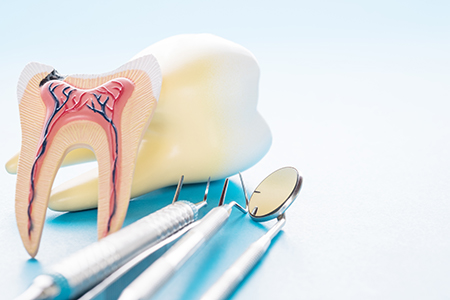

If your dentist has recommended root canal therapy, take comfort in knowing this treatment is a well-established way to relieve pain and preserve a natural tooth. Modern root canal treatment is predictable, comfortable, and focused on removing infection while retaining the strength and appearance of your smile.
At the office of Silk Dental Delray Beach (formerly Marc Bilodeau DMD), we combine gentle techniques with up-to-date technology to make the experience as smooth as possible for our patients. Our team prioritizes comfort, clear explanations, and careful follow-up so you feel confident about the care you receive.
When a tooth’s internal tissues become damaged or infected, removing the tooth is not the only solution. Root canal therapy allows your dentist to remove the diseased tissue inside the tooth, clean and disinfect the internal spaces, and seal them to prevent recurrence. Preserving the original tooth helps maintain normal bite function, jawbone support, and a natural appearance.
Restoration after treatment — often with a crown or other protective restoration — rebuilds the tooth so you can chew comfortably and confidently. In many cases, a properly performed root canal plus a timely restoration will allow the tooth to function for many years, sometimes for the rest of a patient’s life.
Choosing to save a tooth also reduces the need to alter adjacent teeth, which can be required by other replacement options. For most patients, a conservative, tooth-preserving approach supports long-term oral health and helps maintain a more natural, resilient smile.

Each tooth contains a central chamber and narrow channels that house the dental pulp — a network of connective tissue, nerves, and tiny blood vessels. The pulp helps a tooth develop and remain sensitive to temperature and pressure. When decay, a deep fracture, or traumatic injury reaches this inner region, bacteria can invade and cause inflammation or infection.
As the infection progresses, it may cause pain, swelling, and pressure that radiates beyond the tooth itself. In some cases the pulp tissue dies and symptoms become subtle or intermittent, making professional examination and radiographs essential for diagnosis. Timely evaluation helps catch these problems before they spread to surrounding bone or other teeth.
Root canal therapy addresses the problem by removing the affected tissue, cleaning and shaping the internal canals, and sealing them to prevent recontamination. This targeted treatment eliminates the source of infection while keeping the outer tooth structure intact when possible.
Not every toothache requires a root canal, but certain patterns of symptoms commonly indicate deeper involvement of the tooth’s pulp. Persistent or severe pain, especially pain that wakes you at night or lingers after exposure to hot or cold, should prompt a dental visit. Early attention often leads to simpler and more predictable care.
Other warning signs include noticeable swelling near the tooth or gums, a tooth that has darkened or changed color following an injury, and increasing sensitivity when biting or chewing. Sometimes a small pimple-like bump (a sinus tract) appears on the gum near the affected tooth — a sign that an infection is draining and professional treatment is needed.
Even when symptoms are mild or absent, routine dental exams and radiographs may reveal changes at the tip of the root that indicate chronic infection. If your dentist suggests treatment based on clinical or radiographic findings, acting sooner rather than later can help avoid larger problems down the road.
Pain that does not respond to rest or over-the-counter measures and that recurs often is a common sign of inner tooth inflammation or infection. Patients frequently report tooth pain that disrupts sleep or returns after temporary relief.
Sharp or lingering sensitivity to hot or cold foods and beverages often reflects irritation of the inner nerve tissues. When sensitivity persists even after the stimulus is removed, pulp involvement may be present.
Discomfort with pressure or gentle tapping can indicate inflammation or deep structural damage that has reached the tooth’s core. This symptom commonly appears with cracks, fractures, or advanced decay.
A tooth that turns darker than its neighbors may have experienced trauma or long-standing internal changes. Color change can signal that the pulp has been injured or has lost vitality.
Structural injuries can expose the inner tissues and allow bacteria to enter, accelerating the need for endodontic care to protect the tooth’s long-term health.
Gum swelling, tenderness, or an area that drains fluid may point to a developing abscess. Prompt treatment reduces the chance of the infection spreading and helps resolve discomfort.
Increased looseness can result when infection affects the bone supporting the tooth. Often, successful root canal therapy combined with appropriate restoration and follow-up care allows the tissues to heal and stabilize.

Delaying recommended treatment increases the chance that a localized infection will enlarge, involve adjacent teeth, or affect the jawbone. While some infections remain contained for a time, others can cause more extensive damage the longer they are left untreated. Early intervention typically simplifies care and improves outcomes.
Prompt root canal therapy often allows a tooth to be saved with less structural loss and a more predictable restoration process. Waiting can necessitate more complex procedures, including additional restorative work or extraction followed by replacement.
Your dentist will evaluate the tooth’s condition, surrounding bone support, and your overall oral health to determine the most appropriate timing and sequence of care. Acting on professional recommendations helps preserve function and prevents avoidable complications.
Contemporary root canal therapy is a precise procedure performed under local anesthesia to ensure comfort. The dentist accesses the internal chamber, removes the infected or inflamed pulp tissue, and shapes the canals to allow thorough cleaning. Advanced instruments and techniques help remove bacteria and debris while preserving as much of the tooth structure as possible.
Once cleaned, the canals are filled with a biocompatible material and sealed to protect against reinfection. In many cases, a temporary restoration is placed initially, followed by a definitive crown or onlay that restores strength and function. Some treatments can be completed in a single visit; others may require multiple appointments depending on anatomy and the presence of an active infection.
For patients who experience anxiety, additional comfort measures such as nitrous oxide or other sedation options can be discussed. Your dentist will explain the recommended approach, expected timeline, and follow-up steps to ensure a smooth recovery and durable outcome.

After treatment, it is common to experience mild soreness or tenderness for a few days as the surrounding tissues heal. Over-the-counter pain relievers are frequently sufficient, and your dentist will provide guidance about medications if needed. Keeping the treated area clean and following care instructions supports a quicker recovery.
Although the internal infection is addressed during the procedure, restoring the tooth with a permanent crown or suitable restoration is an important next step to protect the tooth from fracture. Until that restoration is in place, it’s wise to avoid chewing hard or sticky foods on the treated tooth.
With appropriate restoration and routine dental care, teeth that have undergone root canal therapy can last many years. Regular checkups and good oral hygiene help detect any changes early and keep your mouth healthy.
You should expect temporary numbness from local anesthesia. Protect your lip and tongue until normal sensation returns to avoid accidental injury.
Mild to moderate soreness is normal for a few days. Follow your dentist’s instructions regarding pain control and call if symptoms persist or worsen.
If antibiotics are prescribed, take the full course as directed to ensure the infection resolves fully. Only use medications as recommended by your dentist.
A temporary filling may be in place initially; avoid chewing directly on the tooth until a permanent restoration is completed to reduce the risk of fracture.
Brushing and flossing around the treated tooth supports healing and helps prevent new problems. Maintain regular dental visits so your dentist can monitor long-term success.
Plan to have the permanent crown or restoration placed promptly so the tooth regains full function and protection.
Root canal therapy is a reliable way to relieve discomfort and preserve natural teeth when performed with careful diagnosis and appropriate restoration. Our team strives to provide thoughtful, evidence-based care that prioritizes your comfort and long-term oral health.
If you have questions about root canal treatment or want to learn whether it is the right option for a specific tooth, please contact us for more information. We are here to help you understand your choices and support your care every step of the way.
A root canal procedure is the best way to save a tooth that has been damaged by decay or injury and preserve your natural smile. The alternative is an extraction and treatment to replace the tooth. While at times a tooth is non-restorable and an extraction is the only option, when possible, it’s best to try and save your natural tooth. With proper care, a tooth with root canal therapy can serve your smile well for many years to come.
Despite lingering myths from before the age of modern dental anesthesia and technology, having a root canal procedure today is as routine and comfortable as visiting the dentist for a filling. While the procedure is performed under local anesthesia with your tooth completely numbed, we can also discuss options in dental sedation.
Whether the symptoms of a dental infection subside after a course of antibiotics, a draining abscess provides you with some temporary pain relief, or a tooth with radiographic evidence of pathology has not yet developed symptoms, it’s essential, before an infection worsens or occurs, to have a root canal procedure performed. In this way, the tooth can be disinfected, filled, and sealed to protect your health and avoid further problems.
If you have sustained a dental injury, have a toothache, jaw pain, swelling, or are experiencing any other unusual and uncomfortable oral symptoms, contact our office immediately for care. Dental problems that have not been evaluated and treated can significantly worsen, producing more severe damage and consequences for the involved teeth, your oral health, and even your overall wellbeing. Once you get in touch with our office, our friendly and compassionate office team will get you in for care at your earliest convenience.
While some root canal procedures can be completed in one visit, others may involve 2 or 3 appointments. How long it takes depends on various factors, including active infection, the number of canals in the tooth, and the tooth’s location or anatomy.
With a success rate that exceeds 95%, root canal therapy remains the most effective procedure to save a tooth in which the inner vital tissues have been damaged. However, as with all healthcare procedures, there are a small percentage of cases where the teeth become symptomatic a second time. The good news is that many of these teeth can still be saved with root canal retreatment or a minor surgical procedure known as an apicoectomy.
The best ways to maintain a tooth with root canal therapy are to get the proper restoration required to rebuild and protect the tooth, maintain proper oral hygiene, and schedule appointments for routine dental checkups and care.
Saving a tooth with root canal therapy is a wise investment that, in the long run, is typically less costly and invasive than having the tooth extracted and replaced with a fixed bridge or implant. As far as the exact cost of care, it can vary depending on which tooth is being treated. Many dental insurance plans provide coverage for root canal therapy. At the office of Silk Dental Delray Beach (formerly Marc Bilodeau DMD), we do our best to optimize your dental benefits and minimize your out-of-pocket expenses. Our staff will answer all your questions about the cost of care and discuss all your payment options.
At the office of Silk Dental Delray Beach (formerly Marc Bilodeau DMD), we use the latest technology and most effective methods of care to provide precise and gentle care. Our reputation for excellence is based upon a consistent record of achieving successful treatment outcomes while providing prompt, stress-free, and convenient treatment for every type of dental need.
Quick Links